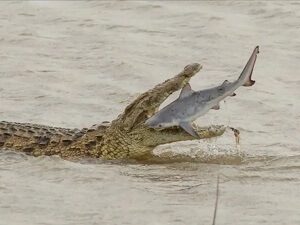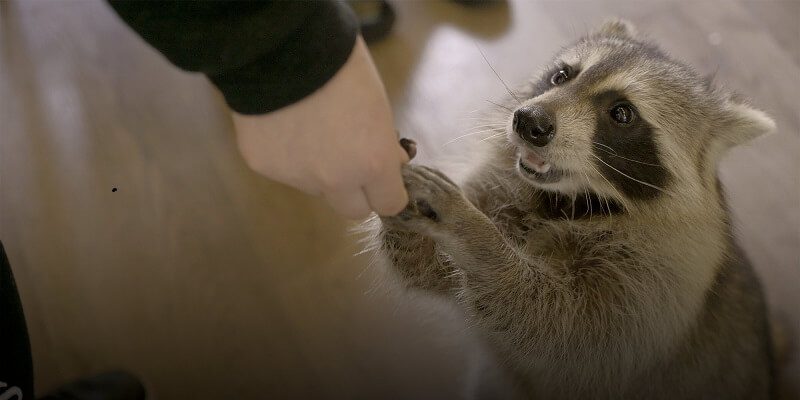Crocodiles are a subfamily of large aquatic reptiles that live in the tropics in Africa, Asia, North America, South America, and Australia. This massive reptile is considered the oldest on Earth, its ancestors being here 250 million years ago.
Crocodiles differ among themselves according to species. The reptile grows throughout its life, but with age, its rhythm is slower. A crocodile can be between 1.20 and 7 meters long. Over time, however, archaeological excavations have found fossils that were 12 meters long.
What do crocodiles eat?
Crocodiles and related species are carnivores. The long jaw and face appearance make them look like they have a sadistic smile, suggesting aggressive and fierce behavior. Most people are terrified of crocodiles, although their food actually depends on their size and the available prey around them.
At first, crocodile babies feed on insects, tadpoles, snails, fish, crayfish, and shells. Because they grow very fast and can only catch small prey animals, they eat very often.
As they grow, they begin to capture larger prey and at the same time increase the duration between two meals. First, they capture larger fish and other reptiles, then gradually they start hunting mammals. It attacks any creature that gets in the way, be it a monkey, buffalo, zebra, snake, or even human when they are hungry. Many animals fall prey to crocodiles while quietly quenching their thirst on the waterfront. Crocodiles also consume corpses; they do not capture only live prey.
You might also like my articles about:
The term opportunist means that the crocodile will consume anything it can find. When young, they feed on insects and other small invertebrates. The diet of adult crocodiles is much more varied. The adult crocodile can hunt small prey that it will not chew, like mollusks, crustaceans, and fish, but also prey bigger than them. They can hunt buffalo, zebras, or even birds. Sometimes they can even destroy the nests of other crocodiles and eat their babies. This is a behavior of animal cannibalism, which can be observed in other animals.
No matter how sharp or blunt the teeth of these animals may be, they are still not suitable for breaking and devouring the meat of their prey. When a crocodile or alligator hunts an animal that quenches its thirst on the shore, it usually catches it and tries to pull it into the water to drown it.
Often, the crocodile has to put the prey in a hole, until its skin softens and the meat begins to break down, because only then can he break it through large bites. Sometimes the crocodile or alligator begins to roll into the water with the prey in its mouth to rip large pieces of meat from it.
Usually, it swallows the whole piece taken in the mouth. Often prey serves as food for several crocodiles who devour it on the spot. Crocodiles capture the fish in small water: They just suddenly close the muzzle and break them down with their teeth.
They swallow the fish completely, the head first, so the gills or bones won’t scratch the fragile tissue of the pharynx. Most crocodile species swallow various things, like stones, and pieces of wood, along with the prey. These probably help digestion that occurs quickly in the stomach.
How often does the crocodile eat?
One of the most characteristic aspects of a crocodile feeding behavior is that it has extraordinarily slow digestion, which is why it does not need to feed often.
A newborn crocodile may be deprived of food for 4 months after a feeding, but in the adult crocodile, it may take two years without eating.
How does a crocodile hunt?
 The crocodile’s body is covered with fleshy plaques, doubled by bone plaques, unwelded between them in the dorsal region, and when hunting it lies hidden underwater to the level of the eyes and nostrils. They are patient predators, who stay even a few hours at the waterfront, waiting and watching the animals coming to drink water. They watch their prey, then jump out of the water and catch it tightly between their extremely powerful jaws. They pull their prey into the water and start a death roll to confuse it, drown it or break pieces of it.
The crocodile’s body is covered with fleshy plaques, doubled by bone plaques, unwelded between them in the dorsal region, and when hunting it lies hidden underwater to the level of the eyes and nostrils. They are patient predators, who stay even a few hours at the waterfront, waiting and watching the animals coming to drink water. They watch their prey, then jump out of the water and catch it tightly between their extremely powerful jaws. They pull their prey into the water and start a death roll to confuse it, drown it or break pieces of it.
It feeds on aquatic and terrestrial animals, and can even eat humans. According to recent studies, crocodile bites have the strongest force in the animal kingdom. The saltwater crocodile, Crocodylus porosus, was the big winner with a force of about 16,460 newtons.
A unique thing about crocodile is that it is one of the few animals that eat stones. In addition to making their digestion easier, the rocks help them sink deeper into the water and catch their prey. Researchers also found that the stones help reptiles to digest, as they often eat whole animals. The crocodile spends most of its life in the aquatic environment, and when it goes out to land it does so to rest.
In the water, they are faster than on land. Over short distances, they can travel quickly and on land too, where the speed record reached by crocodiles is 17 km/h. They are strong swimmers, and in the water, they propel themselves with the help of the tail.
When are crocodiles the most dangerous?
90% of attacks on people occur between November and May. At this time, they guard their territory and protect their offspring. During this period, it is better to refrain from visiting the habitats of these reptiles.
Are Crocodiles dangerous to humans?
Even though they are thought by some to be human eaters, researchers believe that deadly assaults are a reflex triggered by human provocative behavior. The reptiles’ attacks on humans are a response to the defense instinct for territory or offspring.
Over the past 10 years, there have been more than 200 cases of attacks on people in America. In 2006, several deadly attacks occurred in Florida on rivers that intertwine with people’s homes.
In Australia, the crocodile is protected by law, and hunting is prohibited because it is considered very important for the balance of the ecosystem.
Crocodiles can have a territorial instinct. In Australia, three saltwater crocodiles who were relocated by helicopter returned to their original locations within 3 weeks, based on data obtained from the devices attached to them.




